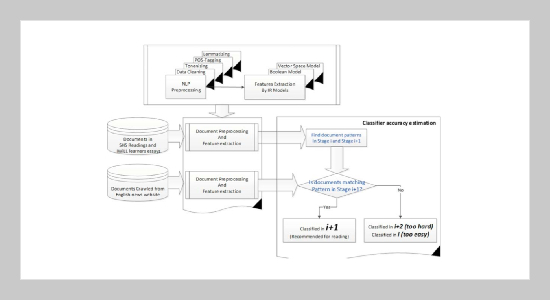REFERENCES
- [1] Nakamura, J. and Csikszentmihalyi, M., “The Concept of Flow,” Handbook of Positive Psychology, pp. 89 105 (2002). doi: 10.1007/978-94-017-9088-8_16
- [2] Csikszentmihalyi, M., Finding Flow, New York: Basic (1997).
- [3] Csikszentmihalyi, M., Beyond Boredom and Anxiety, Jossey-Bass Publishers, pp. 102000, Original work published (1975).
- [4] Krashen, S. D., Principles and Practice in Second Language Acquisition, New York: Phoenix ELT, pp. 2030 (1995).
- [5] Danielson, W. A. and Bryan, S. D., “Computer Automation of Two Readability Formulas,” Journalism Quarterly, pp. 201206 (1963). doi: 10.1177/1077 69906304000207
- [6] Chall, J. S. and Dale, E., Readability Revisited: The New ale-Chall Readability Formula, Cambridge, MA: Brookline Books (1995).
- [7] Chall, J. S., Readability: An Appraisal of Research and Publication, Bureau of Educational Research Monographs, Columbus: Ohio State University Press, Epping, England: Bowker (1958).
- [8] Klare, G. R., The Measurement of Readability, Ames: Iowa State University Press (1963). doi: 10.1177/ 002194366400100207
- [9] Williams, C. B., “A Note on the Statistical Analysis of Sentence Length as a Criterion of Literary Style,” Biometrika Trust, Vol. 31, No. 3, pp. 356361 (1940). doi: 10.2307/2332615
- [10] Zhang, L., Liu, Z. and Ni, J., “Feature-Based Assessment of Text Readability,” Seventh International Conference on Internet Computing for Engineering and Science, pp. 5154 (2013). doi: 10.1109/ICICSE.2013.18
- [11] Thompson, K. C. and Callan, J., “Predicting Reading Difficulty with Statistical Language Models,” Journal of the American Society For Information Science and Technology, Vol. 56, pp. 14481462 (2005). doi: 10.1002/asi.20243
- [12] Petersen, S. E. and Ostendorf, M., “A Machine Learning Approach to Reading Level Assessment,” Computer Speech and Language, Vol. 23, pp. 89106 (2009). doi: 10.1016/j.csl.2008.04.003
- [13] Heilman, M., Zhao, L., Pinoand, J. and Eskenazi, M., “Retrieval of Reading Materials for Vocabulary and Reading Practice,” Proceedings of the Third ACL Workshop on Innovative Use of NLP for Building Educational Applications, pp. 8088 (2008). doi: 10. 3115/1631836.1631846
- [14] Miltsakaki, E., “Matching Readers Preferences and Reading Skills with Appropriate Web Texts,” Proceedings of the European Chapter of the Association for Computational Linguistics (EACL) Demonstrations Session, pp. 4952, Athens, Greece (2009). doi: 10. 3115/1609049.1609062
- [15] Martin, L. and Gottron, T., “Readability and the Web,” Future Internet, Vol. 4, No. 1, pp. 238252 (2012). doi: 10.3390/fi4010238
- [16] Kincaid, J. P., Fishburne, Jr., R. P., Rogers, R. L. and Chissom, B. S., “Derivation of New Readability Formulas (Automated Readability Index, Fog Count and Flesch Reading Ease Formula) for Navy Enlisted Personnel,” Research Branch Report, pp. 875, Millington, TN: Naval Technical Training, U. S. Naval Air Station, Memphis, TN (1975).
- [17] McLaughlin, G. H., “SMOG Grading - A New Readability Formula,” Journal of Reading, Vol. 12, No. 8, pp. 639646 (1969).
- [18] Gunning, R., The Technique of Clear Writing, New York, NY: McGraw-Hill International Book Co. (1952).
- [19] Pitler, E. and Nenkova, A., “Revisiting Readability: A Unified Framework for Predicting Text Quality,” Proceedings of the 2008 Conference on Empirical Methods in Natural Language Processing, pp. 186195, Honolulu (2008). doi: 10.3115/1613715.1613742
- [20] Sanmin, available from http://www.sanmin.com.tw/ page-history.asp, retrieved (2011).
- [21] IWiLL, available from http://cube.iwillnow.org, retrieved (2012).
- [22] GEPT, General English Proficiency Test, available from http://www.gept.org.tw, retrieved (2011).
- [23] LTTC, available from http://www.lttc.ntu.edu.tw, retrieved (2012).
- [24] CNN, available from http://edition.cnn.com/, retrieved (2011).
- [25] The China Post, available from http://chinapost.com. tw/, retrieved (2011).
- [26] BBC, available from http://www.bbc.co.uk/, retrieved (2011).
- [27] Bird, S., Klein, E., Loper, E. and Baldridge, J., “Multidisciplinary Instruction with the Natural Language Toolkit,” Proceedings of the Third Workshop on Issues in Teaching Computational Linguistics, Association for Computational Linguistics, Stroudsburg, PA, USA, pp. 6270 (2008). doi: 10.3115/1627306.1627317
- [28] Orange, Analyze Process through Visual Programming, available from http://orange.biolab.si/features. html, retrieved (2013).
- [29] Liu, B., “Information Retrieval and Web Search, Web Data Mining: Exploring Hyperlinks, Contents, and Usage Data,” Springer (2007). doi: 10.5860/CHOICE.49-2718
- [30] Ito, K., Encyclopedic Dictionary of Mathematics, 2nd edition, p. 82, p. 113, p. 144, p. 145, MIT Press, ISBN 978-0-262-59020-4 (1993).
- [31] Apostol, T., Calculus, Multi-Variable Calculus and Linear Algebra with Applications, Vol. 2, John Wiley and Sons, ISBN 9780471000075 (1969).
- [32] Kohavi, R., “A Study of Cross-Validation and Bootstrap for Accuracy Estimation and Model Selection,” Proceedings of the Fourteenth International Joint Conference on Artificial Intelligence, Vol. 2, No. 12, pp. 11371143, (Morgan Kaufmann, San Mateo, CA) (1995).
- [33] Konchady, M., Text Mining Application Programming, Boston, Mass: Charles River Media (2006).
- [34] Senter, R. J. and Smith, E. A., Automated Readability Index, Wright Patterson Air Force Base, P. iii, AMRLTR-6620 (1967).
- [35] Coleman, M. and Liau, T. L., “AComputer Readability Formula Designed for Machine Scoring,” Journal of Applied Psychology, Vol. 60, pp. 283284 (1975). doi: 10.1037/h0076540
- [36] Kincaid, J. P., Braby, R. and Mears, J., “Electronic Authoring and Delivery of Technical Information,” Journal of Instructional Development, Vol. 11, No. 813 (1988). doi: 10.1007/BF02904998
















